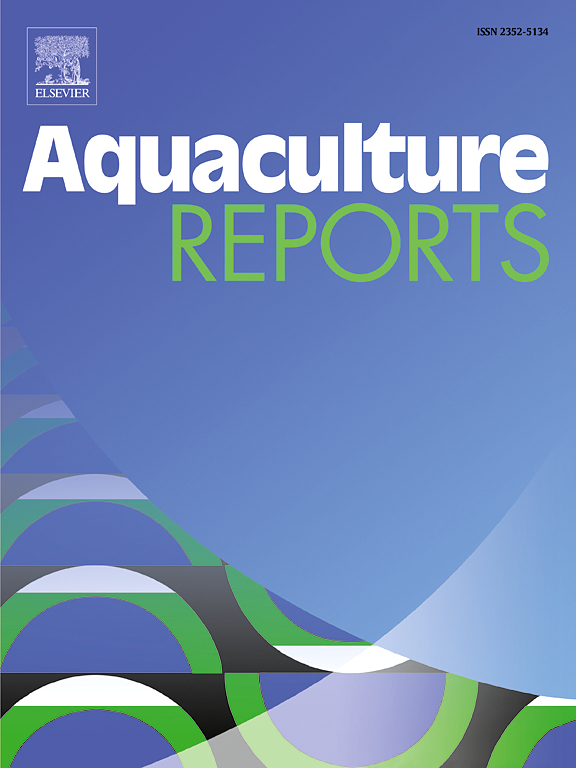Utilization of ursolic acid methyl ester in the treatment of Streptococcus pyogenes in Nile tilapia, concerning physiological, genetic, immune-oxidative, stress, and neuro-ethological parameters
IF 3.2
2区 农林科学
Q1 FISHERIES
引用次数: 0
Abstract
The present work is an innovative approach for application the Streptomyces misakiensis S. misakiensis metabolite called ursolic acid methyl ester (UAME) in treating Streptococcus pyogenes of Nile tilapia. A total of 110 fish was used for assessment of the therapeutic dose of UAME. In addition, the therapeutic efficacy of UAME was tested in vivo against S. pyogenes infection (after determination of LC50) using 200 Nile tilapia. Fish (30.00 ± 1.5 g) were divided into four groups: CON (control), UAME (1.0 mg/L), S. pyogenes, and UAME (1.0 mg/L) + S. pyogenes groups. The inoculations of 0.2 mL of S. pyogenes (1 ×107 CFU/mL) were administered to the fish in the S. pyogenes and UAME + S. pyogenes groups and continued for ten days. The minimal inhibitory concentration of UAME was 0.5 µg/mL. Moreover, irregularity and bacterial cell shape distortion were evident after treatment with UAME under a scanning Electron Microscope. Challenged groups in S. pyogenes exhibited significant increases in surfacing frequency, swimming, laterality and aggression behavior (P < 0.05). Along with this, the hepatorenal metrics (ALT, ALP, AST, creatinine, total bilirubin, and urea.), MDA (an oxidant biomarker), (8-OHdG), glucose and cortisol (stress indicators) were all significantly elevated in the diseased fish (P < 0.05). Contrariwise, the infected fish showed a significant drop (P < 0.05) in survival %, red blood cells, hemoglobin, total proteins, total globulin, albumin, AchE activity, and the immune-antioxidant indices (IgM, complement factor 3, lysozyme activity, nitric oxide, hepatic CAT, SOD, GSH, and GPx). Analysis of genes in response to S. pyogenes infection demonstrated an up-regulation of the pro/anti-inflammatory genes (il1b, tnfa, il8, tgfb, il10). Surprisingly, enriched groups in UAME modulated all the measured parameters. Overall, UAME is a promising antibacterial candidate that can efficiently retrieve stress and enhance behavioral, biochemical, immune-antioxidant, and genetic changes endowed by S. pyogenes infection.
熊果酸甲酯在尼罗罗非鱼化脓性链球菌治疗中的应用,涉及生理、遗传、免疫氧化、应激和神经行为学参数
本研究是利用misakistreptomyces misakiensis S.代谢物熊果酸甲酯(UAME)治疗尼罗罗非鱼化脓性链球菌的创新方法。共有110条鱼被用于评估UAME的治疗剂量。另外,用200只尼罗罗非鱼在体内检测了UAME对化脓性链球菌感染的治疗效果(LC50测定后)。鱼(30.00 ± 1.5 g)分为4组:CON(对照)、UAME(1.0 mg/L)、S. pyogenes和UAME(1.0 mg/L) + S。化脓性链球菌组。分别接种0.2 mL(1 ×107 CFU/mL)的化脓性链球菌和UAME + S。化脓性组,持续10天。UAME的最低抑菌浓度为0.5 µg/mL。在扫描电镜下观察到UAME处理后细菌细胞的不规则性和形状畸变明显。攻毒组的上浮频率、游动、侧度和攻击行为显著增加(P <; 0.05)。与此同时,患病鱼的肝肾指标(ALT、ALP、AST、肌酐、总胆红素和尿素)、MDA(一种氧化生物标志物)、(8-OHdG)、葡萄糖和皮质醇(应激指标)均显著升高(P <; 0.05)。相反,感染鱼的存活率、红细胞、血红蛋白、总蛋白、总球蛋白、白蛋白、AchE活性和免疫抗氧化指标(IgM、补体因子3、溶菌酶活性、一氧化氮、肝脏CAT、SOD、GSH和GPx)均显著下降(P <; 0.05)。对化脓性链球菌感染相关基因的分析显示,促/抗炎基因(il1b、tnfa、il8、tgfb、il10)上调。令人惊讶的是,UAME中富集的基团调节了所有测量参数。总之,UAME是一种很有前途的抗菌候选药物,可以有效地恢复应激,增强化脓性链球菌感染赋予的行为、生化、免疫抗氧化和遗传变化。
本文章由计算机程序翻译,如有差异,请以英文原文为准。
求助全文
约1分钟内获得全文
求助全文
来源期刊

Aquaculture Reports
Agricultural and Biological Sciences-Animal Science and Zoology
CiteScore
5.90
自引率
8.10%
发文量
469
审稿时长
77 days
期刊介绍:
Aquaculture Reports will publish original research papers and reviews documenting outstanding science with a regional context and focus, answering the need for high quality information on novel species, systems and regions in emerging areas of aquaculture research and development, such as integrated multi-trophic aquaculture, urban aquaculture, ornamental, unfed aquaculture, offshore aquaculture and others. Papers having industry research as priority and encompassing product development research or current industry practice are encouraged.
 求助内容:
求助内容: 应助结果提醒方式:
应助结果提醒方式:


